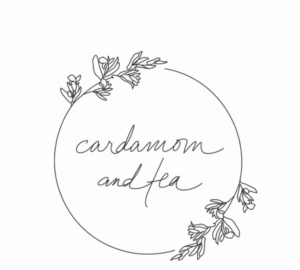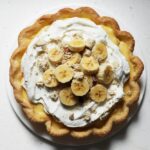banana cream pie with halva and cardamom

- Prep Time: 35 minutes
- Total Time: 4 1/2 hours
- Yield: 8 servings
Ingredients
for the crust:
- 200g all purpose flour (about 1 1/2 cups)
- 3.5g salt (1/2 teaspoon)
- 130g cold unsalted butter, cut into chunks (9 tablespoons)
- 60g cold yogurt (1/4 cup)
- 15g cold water (1 tablespoon)
for the pastry cream filling:
- 270g milk (1 cup + 2 tablespoons)
- 50g sugar (1/4 cup)
- 8g all purpose flour (about 1 tablespoon)
- 10g cornstarch (about 1 tablespoon + 1 teaspoon)
- 2g salt (1/4 teaspoon)
- 1 large egg (60g)
- 40g butter (3 tablespoons)
- 1/4 teaspoon cardamom (0.5g)***
- 1/8 teaspoon vanilla extract (0.5g)
For the filling and toppings:
- 2 ripe bananas, sliced between 1/4- to 1/2-inch thick (190g out of their peels)
- baked pie shell (above)
- 75g sesame halva****, crumbled (3/4 cup)
- warm pastry cream (above)
- 20g sugar (1 1/2 tablespoons)
- 175g cold whipping cream (3/4 cup)
- 1 pinch of salt
- more halva and bananas for topping (I used 1/3 cup more halva and 1 banana)
Instructions
- To make the crust: Place the flour, salt, and butter in a food processor fitted with the blade attachment. Pulse several times, until the butter blends into the flour, and there aren’t any lumps bigger than a tic tac. Add the yogurt, and pulse 2 or 3 times to distribute. Drizzle in the water.* Pulse a few times until it can be squeezed together into a pliable and smooth dough (don’t over-process).
- Shape the dough into a ball, flatten the ball into a disc, cover with plastic wrap, and refrigerate for 30 minutes.
- On a lightly floured surface, roll the chilled dough out to between 1/8- to 1/4-inch thick; it should be wider than the pie pan (about 13-13.5 inches). Rotate occasionally as you work, but try not to handle the dough too much.
- Once it’s rolled out, gently wrap it around your rolling pin to transfer it to the pie pan. Unroll it onto a 9-inch pie pan and gently press the dough into place so it’s in contact with the entire pan. Use scissors to trim some of the excess off, but leave about 3/4-inch of dough hanging past the edge of the pan. Go back and fold the edge under itself so it still overhangs by just about 1/8-inch (you shouldn’t be able to see the pan from above). Crimp, let it sit at cool room temperature for 10 minutes, then refrigerate for 90 minutes.
- Preheat the oven to 400°F (205°C) convection once the dough is almost done chilling.
- Once the pie shell is ready to bake, dock it all over with a fork, and bake for about 20 minutes total, until golden brown. About 5 minutes into baking, check on it to see if it’s sliding or puffing too much on the bottom. Take it out and dock it again with a fork to make it collapse, and nudge it back into place if it’s shrinking/sliding. Put it back in the oven, and check on it again after another 5 to 10 minutes, repeating if it’s puffing up again. Or feel free to use pie weights instead if this all sounds like a hassle (see note). **
- To make the pastry cream: In a medium saucepan, bring the milk to a simmer over medium heat, stirring occasionally to make sure the bottom isn’t scorching.
- Combine the sugar, flour, cornstarch, salt, and egg in a medium stainless steel mixing bowl. Whisk together until it’s totally lump-free. Once the milk comes to a simmer, slowly drizzle it into the egg mixture while whisking constantly. Return it to the medium saucepan, and set it over medium heat. Don’t stop whisking as it heats—remove from heat once it thickens and big bubbles start to break to the surface.
- Immediately add the butter, cardamom, and vanilla, and whisk constantly until the butter melts from the residual heat and and fully mixes in. Move onto the next part while the custard is still warm (or let it rest off the heat for 1-2 hours, and then reheat over very low heat while whisking constantly, just until it is pourable again).
- To fill the pie: Arrange the banana slices on the bottom of the baked pie shell. Top with the 3/4 cup/75g halva crumbles. Pour on the warm pastry cream, and halfway through give the pan a few bangs to make sure there aren’t any trapped air pockets. Smooth it out, and refrigerate for at least 90 minutes, until it’s completely chilled.
- While you’re waiting on the pie to chill, place the sugar in the bowl of your stand mixer (or a stainless steel bowl), and place it along with the whisk attachment (or a regular whisk) in the refrigerator to chill.
- When the pie is ready to come out of the refrigerator, whip the cream: add the whipping cream and a pinch of salt to the sugar, and beat at medium-high speed, until it reaches medium peaks (don’t beat it all the way to stiff peaks unless you plan to pipe it).
- Top the pie with the whipped cream, not quite spreading it all the way out to the edges, and making little swooshes on the surface with a small offset spatula or knife. Top with a few banana slices, some halva crumbles, and a tiny pinch of cardamom. You can also serve it at the table with extra toppings (especially extra halva for anyone who can’t get enough sesame). Store in the refrigerator.
Notes
* If you measured precisely in grams, you can add the water all at once. If you’re using volume, you should add the water in 2 installments, and you might even need to add a bit more to get it to hold together (volume is less precise).
** To prevent shrinking and puffing in the first place, you can use pie weights. If you go the pie weight route, you don’t need to do the whole thing with the folded-under crust, and you don’t need to let it rest in the refrigerator for so long. I hate pie weights, and always use this method to avoid them, but some might find this technique more trouble than it’s worth, and it’s totally a matter of preference. If you use pie weights, your pastry won’t be as flaky and puffy, and you’ll need to bake it for a few minutes without the weights to make sure the bottom browns. If you’re new to baking, you might want to try using weights, because it’s a little easier and failproof.
*** The cardamom should be a background flavor, so make sure you don’t add too much. If you add too much it will taste like soapy perfume, so remember that less is more.
**** You can find halva in most Middle Eastern markets, as well as some supermarkets with good international aisles.
